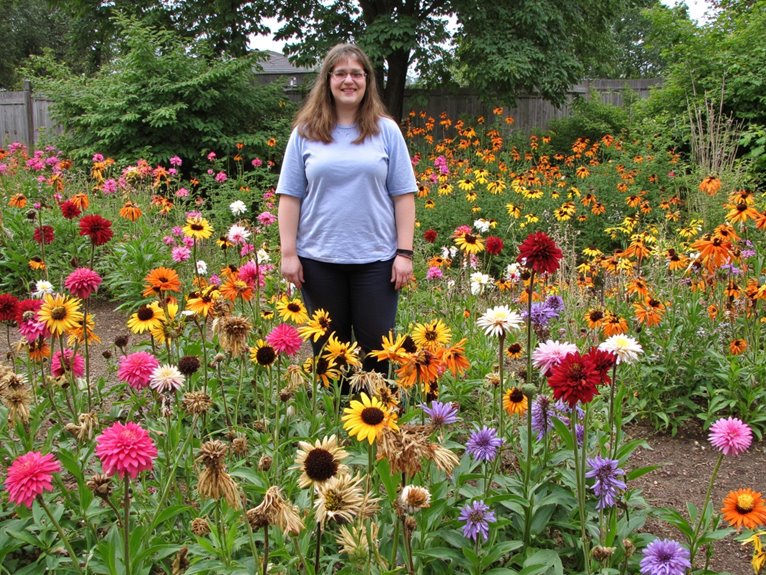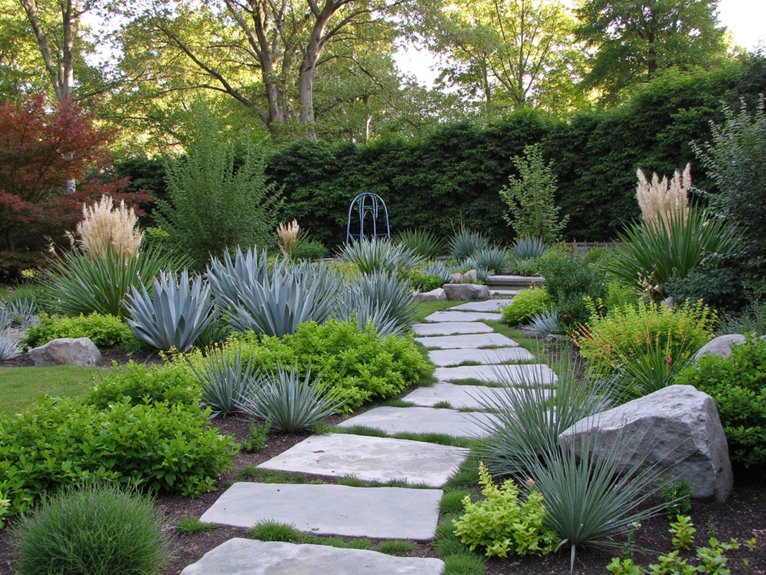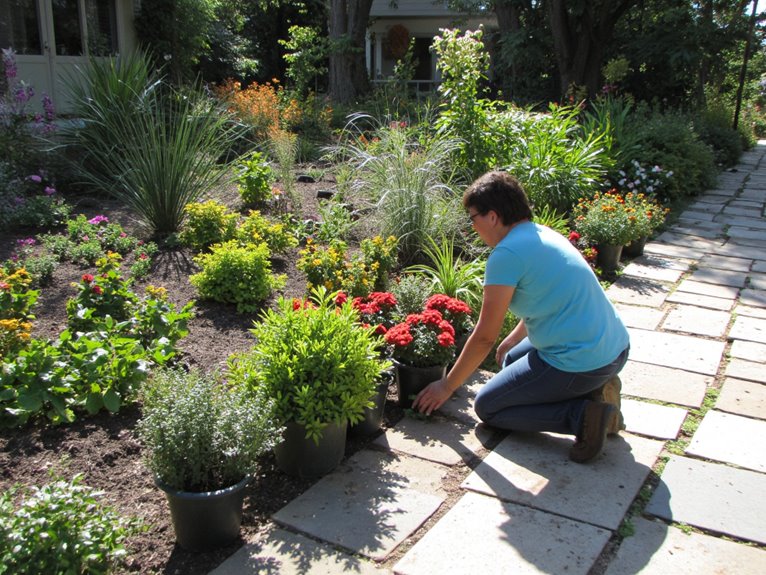Window Direction and Plant Selection: Matching Garden Plants to Available Natural Light
Your window direction shapes your plant choices—south-facing spots need drought-tolerant succulents like aloe vera or cacti, while north-facing areas work best for shade-loving species such as snake plants or peace lilies. West windows offer afternoon sun perfect for herbs like rosemary and sage, whereas east exposures provide gentle morning light ideal for variegated pothos or monstera deliciosa. Position plants 0.5-1 meter from windows to balance light exposure and prevent scorching. By matching plants to their natural light needs, you’ll create thriving indoor gardens that flourish in your space. As you explore further, you’ll discover how to measure sunlight precisely and recognize when plants need more or less light.
Notable Insights
- South-facing windows provide intense midday light, perfect for cacti, succulents, and Mediterranean herbs.
- North-facing windows offer soft, consistent light—ideal for ferns, snake plants, and peace lilies.
- East windows receive gentle morning sun, while west windows get harsh afternoon rays requiring shade cloths.
- Choose low-light plants like pothos or ZZ plants for north-facing spaces with minimal natural light.
- Position plants 0.5–1 meter from windows to avoid scorching and balance sunlight exposure.
Sunlight Intensity by Window Direction
Depending on which way your window faces, the sun’s energy will arrive in very different forms, each offering unique opportunities and challenges for plant life. South-facing windows bask in longest sunlight duration, with intense midday light perfect for heat-loving plants but risking scorch if unshaded. North windows deliver soft, consistent light ideal for shade-tolerant species. East exposures provide gentle morning sun, while west windows receive harsh afternoon rays. Intensity variations mean you’ll need to match plants to their specific needs—think succulents for south-facing heat or ferns for northlight’s calm glow. When maintaining plants near windows, consider that ergonomic design features in gardening tools can minimize fatigue during prolonged trimming and care sessions. Solar heat transmission values ranging from 0.2 to 0.8 illustrate how different window orientations significantly impact the amount of heat energy entering your space, influencing both plant selection and energy efficiency considerations.
Understanding Plant Light Requirement Categories
Light levels in your home can make or break your greenery – think about how different plants need different conditions. Understanding plant light requirement categories helps you match species to their ideal light exposure. Full sun plants thrive on 6+ hours of direct sunlight, while low light varieties show greater shade tolerance. Bright indirect light suits tropical houseplants that avoid leaf burn yet still grow robustly. Medium light plants handle variable intensities well, and partial sun/shade species prefer filtered rays or morning/afternoon sun. Knowing these categories guarantees your plants receive the right conditions to flourish without stress or decline.
By understanding these categories, you can make informed decisions about which plants to place where – for example, knowing that Partial Sun conditions (3-6 hours of direct sunlight) are perfect for many ornamental shrubs and flowering perennials. For indoor gardening enthusiasts, windowsill spaces provide excellent opportunities to grow fresh herbs like mint, rosemary, and basil that can thrive in bright, indirect light conditions.
Plant Selection for South-Facing Windows
Your home’s southern exposure offers a unique opportunity to grow plants that really shine – quite literally. South facing plants need direct sunlight care, so choose species like cacti, succulents, or Mediterranean herbs. These thrive in intense light but may require protection from overheating. Aloe vera and monstera deliciosa are great options with the right balance of sun and shade. Remember to rotate them regularly and monitor soil moisture closely.
For particularly sensitive plants, proper positioning – keeping them 0.5-1 meter from windows – helps mitigate risks of scorching during summer months. Additionally, consider adding solar garden lights to extend the growing season and provide supplemental illumination during shorter winter days. With careful selection and placement, your south-facing window can become a thriving garden oasis full of vibrant, sun-loving flora.
Choosing Plants for West-Facing Windows
While west-facing windows offer vibrant afternoon sun rather than constant daylight, they create a perfect habitat for plants that thrive in warm, bright conditions. These spaces are ideal for sun-loving species like rosemary, sage, and bougainvillea, which flourish under intense but limited direct light.
Personal care routines should include monitoring soil moisture closely due to rapid drying from warm rays. Proper plant placement—away from scorching afternoon heat or near shaded areas—ensures your greenery thrives without stress.
Remember to rotate plants regularly for even growth and consider variegated varieties like Monstera or Pothos that maintain their color beautifully in west-facing light. With thoughtful selection and care, your west window can become a stunning display of resilient, sun-drenched flora.
Matching Plants to East-Facing Windows
| Plant Group | Light Intensity Needs | Suitability for East Windows | Care Notes |
|---|---|---|---|
| Ferns | Medium indirect light | High | Keep near sill for morning sun |
| Flowering | Bright indirect | Medium | Position to catch direct light |
| Foliage | Low to medium | High | Avoid midday heat |
Ideal plant choices include Pothos, African violets, and Fiddleleaf figs. These thrive with the moderate light and cooler temperatures of an east-facing window.
Options for North-Facing Window Gardens
If you’re aiming to create a thriving garden near a north-facing window, focus on species that thrive in low light and minimal water needs. Snake Plants and ZZ Plants form great plant combinations with Peace Lilies for shady spaces. Pothos vines add visual interest while Cast-Iron Plants offer durability. For winter care, reduce watering as light levels drop but keep them close to windows. These plants’ resilience makes them perfect for cooler, darker conditions typical of north-facing exposures.
Measuring Available Sunlight for Plants
Whether you’re planning a new garden or simply want to improve your existing space, understanding how much sunlight your plants receive is essential for their health and growth. To measure light accurately, use a light meter for quantitative data, conduct manual sun mapping by observing exposure daily, or try smartphone apps that track solar patterns. Proper light measurement techniques help create detailed sun exposure documentation, categorizing areas as full sun, partial shade, or full shade. Document these zones to guide plant selection and placement, ensuring each species thrives in its ideal conditions.
Recognizing Signs of Inadequate or Excessive Light
Once you’ve measured your space’s light conditions, the next step is recognizing how plants respond to too much or too little sun. Excessive light causes leaf scorch – brown, bleached spots on the side facing the window. Plants show light stress through brittle leaves and round brown spots that darkened over time. On the flip side, inadequate light leads to leggy growth, pale yellow leaves, and stems that twist toward the light. These plant symptoms signal when your greenery needs more or less sun. If you notice scorched leaves, trim them but remember they won’t recover. For stretched, pale plants, consider moving them closer to a light source or supplementing with grow lights. Pay attention to these visual cues; they’ll help you keep your garden thriving.
Frequently Asked Questions
Can I Use Artificial Light to Supplement My North-Facing Garden?
Yes, you can use artificial lighting to supplement your north-facing garden. It supports plant growth by providing essential light intensity for photosynthesis when natural light is limited.
How Do Seasonal Changes Affect Indoor Plant Light Needs?
Seasonal changes mess with your plants’ light adaptation, slowing seasonal growth in winter when days shorten and sunlight weakens. You’ll need more artificial light then, but remember to ease them back in spring to avoid shocking their system.
Are There Plants That Thrive in Both Sun and Shade?
Yes, there are shade loving plants like hostas and astilbe that also handle sun with proper care. Sun tolerant varieties such as Turk’s cap and begonias adapt well to partial shade too. These versatile choices work in both conditions when given the right soil and water.
What About Windows With Partial Sun and Partial Shade?
Partial sun and partial shade windows need thoughtfully chosen plants that can handle varying light conditions. Look for species like ferns, hostas, or heucheras that thrive in lower light but still get some sun. These plant choices will flourish without being scorched by direct exposure.
Do Reflective Surfaces Really Help Shady Gardens?
Reflective surfaces can definitely help shady gardens by boosting light intensity. They work like reflective barriers, redirecting sunlight where it’s needed most. This makes a big difference in how bright these spaces feel.
On a final note
With thoughtful plant selection based on your window’s light exposure, you can create a thriving garden tailored to your home’s unique conditions. Remember that each plant has specific needs, and understanding these will help you make informed choices for your space. As you experiment and observe, you’ll develop the skills needed to nurture a beautiful indoor garden. Keep learning and let nature inspire your green thumb!






